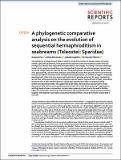Por favor, use este identificador para citar o enlazar a este item:
http://hdl.handle.net/10261/206575COMPARTIR / EXPORTAR:
 SHARE SHARE
 CORE
BASE CORE
BASE
|
|
| Visualizar otros formatos: MARC | Dublin Core | RDF | ORE | MODS | METS | DIDL | DATACITE | |

| Título: | A phylogenetic comparative analysis on the evolution of sequential hermaphroditism in seabreams (Teleostei: Sparidae) |
Autor: | Pla Quirante, Susanna CSIC ORCID; Benvenuto, Chiara; Capellini, Isabella; Piferrer, Francesc CSIC ORCID | Fecha de publicación: | 27-feb-2020 | Editor: | Springer Nature | Citación: | Scientific Reports 10: 3606 (2020) | Resumen: | The Sparids are an ideal group of fishes in which to study the evolution of sexual systems since they exhibit a great sexual diversity, from gonochorism (separate sexes) to protandrous (male-first) and protogynous (female-first) sequential hermaphroditism (sex change). According to the size-advantage model (SAM), selection should favour sex change when the second sex achieves greater reproductive success at a larger body size than the first sex. Using phylogenetic comparative methods and a sample of 68 sparid species, we show that protogyny and protandry evolve from gonochorism but evolutionary transitions between these two forms of sequential hermaphroditism are unlikely to happen. Using male gonadosomatic index (GSI) as a measure of investment in gametes and proxy for sperm competition, we find that, while gonochoristic and protogynous species support the predictions of SAM, protandrous species do not, as they exhibit higher GSI values than expected even after considering mating systems and spawning modes. We suggest that small males of protandrous species have to invest disproportionally more in sperm production than predicted not only when spawning in aggregations, with high levels of sperm competition, but also when spawning in pairs due to the need to fertilize highly fecund females, much larger than themselves. We propose that this compensatory mechanism, together with Bateman’s principles in sequential hermaphrodites, should be formally incorporated in the SAM | Descripción: | 12 pages, 5 figures, 3 tables, supplemental material https://doi.org/10.1038/s41598-020-60376-w.-- The datasets supporting this article have been uploaded as part of the supplementary material | Versión del editor: | https://doi.org/10.1038/s41598-020-60376-w | URI: | http://hdl.handle.net/10261/206575 | DOI: | 10.1038/s41598-020-60376-w | Identificadores: | doi: 10.1038/s41598-020-60376-w e-issn: 2045-2322 |
| Aparece en las colecciones: | (ICM) Artículos |
Ficheros en este ítem:
| Fichero | Descripción | Tamaño | Formato | |
|---|---|---|---|---|
| Pla_et_al_2020.pdf | 1,95 MB | Adobe PDF |  Visualizar/Abrir | |
| Pla_et_al_2020_suppl.docx | 89,09 kB | Microsoft Word | Visualizar/Abrir |
CORE Recommender
PubMed Central
Citations
4
checked on 13-abr-2024
SCOPUSTM
Citations
17
checked on 19-abr-2024
WEB OF SCIENCETM
Citations
14
checked on 25-feb-2024
Page view(s)
230
checked on 24-abr-2024
Download(s)
328
checked on 24-abr-2024

